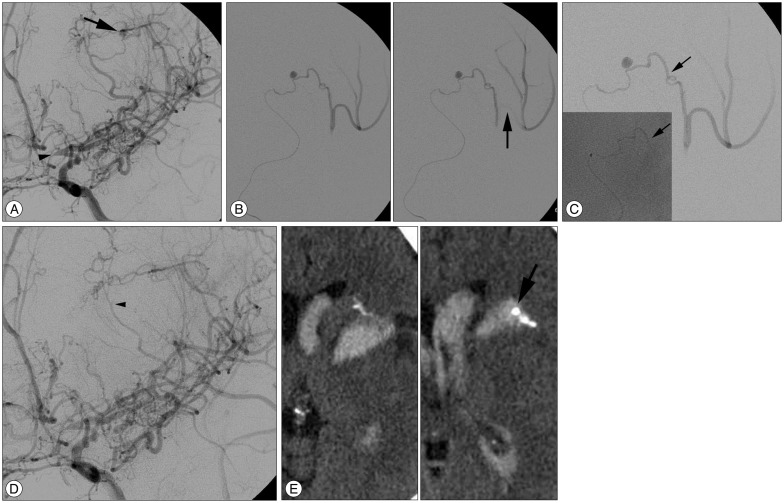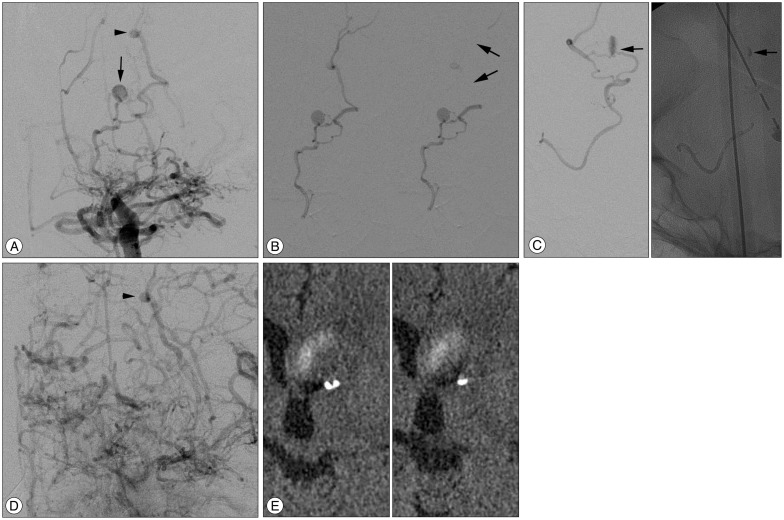J Korean Neurosurg Soc.
2014 Dec;56(6):492-495. 10.3340/jkns.2014.56.6.492.
Endovascular Embolization of a Ruptured Distal Lenticulostriate Artery Aneurysm in Patients with Moyamoya Disease
- Affiliations
-
- 1Department of Neurosurgery, Seoul National University Bundang Hospital, Seongnam, Korea. storynlemon@gmail.com
- KMID: 2191141
- DOI: http://doi.org/10.3340/jkns.2014.56.6.492
Abstract
- A ruptured distal lenticulostriate artery (LSA) aneurysm is detected occasionally in moyamoya disease (MMD) patients presented with intracerebral hemorrhage. If the aneurysm is detected in hemorrhage site on angiographic evaluation, its obliteration could be considered, because it rebleeds frequently, and is associated with poorer outcome and mortality in MMD related hemorrhage. In this case report, the authors present two MMD cases with ruptured distal LSA aneurysm treated by endovascular embolization.
MeSH Terms
Figure
Cited by 1 articles
-
Recurrent Bleeding in Hemorrhagic Moyamoya Disease : Prognostic Implications of the Perfusion Status
Kyung-Il Jo, Min Soo Kim, Je Young Yeon, Jong-Soo Kim, Seung-Chyul Hong
J Korean Neurosurg Soc. 2016;59(2):117-121. doi: 10.3340/jkns.2016.59.2.117.
Reference
-
1. Chalouhi N, Tjoumakaris S, Gonzalez LF, Dumont AS, Shah Q, Gordon D, et al. Onyx embolization of a ruptured lenticulostriate artery aneurysm in a patient with moyamoya disease. World Neurosurg. 2013; 80:436.e7. 436.e10. PMID: 22484074.
Article2. Cho HJ, Roh HG, Moon WJ, Kim HY. Perforator territory infarction in the lenticulostriate arterial territory : mechanisms and lesion patterns based on the axial location. Eur Neurol. 2010; 63:107–115. PMID: 20090345.
Article3. Harreld JH, Zomorodi AR. Embolization of an unruptured distal lenticulostriate aneurysm associated with moyamoya disease. AJNR Am J Neuroradiol. 2011; 32:E42–E43. PMID: 20075103.
Article4. Kim SH, Kwon OK, Jung CK, Kang HS, Oh CW, Han MH, et al. Endovascular treatment of ruptured aneurysms or pseudoaneurysms on the collateral vessels in patients with moyamoya disease. Neurosurgery. 2009; 65:1000–1004. discussion 1004. PMID: 19834414.
Article5. Larrazabal R, Pelz D, Findlay JM. Endovascular treatment of a lenticulostriate artery aneurysm with N-butyl cyanoacrylate. Can J Neurol Sci. 2001; 28:256–259. PMID: 11513346.
Article6. Nah HW, Kwon SU, Kang DW, Ahn JS, Kwun BD, Kim JS. Moyamoya disease-related versus primary intracerebral hemorrhage : [corrected] location and outcomes are different. Stroke. 2012; 43:1947–1950. PMID: 22693130.
Article7. Saeki N, Nakazaki S, Kubota M, Yamaura A, Hoshi S, Sunada S, et al. Hemorrhagic type moyamoya disease. Clin Neurol Neurosurg. 1997; 99(Suppl 2):S196–S201. PMID: 9409437.
Article
- Full Text Links
- Actions
-
Cited
- CITED
-
- Close
- Share
- Similar articles
-
- A Ruptured lenticulostriate artery aneurysm in moyamoya disease treated with Onyx embolization
- Successful Endovascular Treatment of Ruptured Superior Cerebellar Artery Aneurysm Associated with Moyamoya Disease : A Case Report and Review of the Literature
- Ruptured Distal Lenticulostriate Artery Aneurysm Associated with Ipsilateral Middle Cerebral Artery Occlusion : Case Report
- Coil Embolization for Distal Middle Cerebral Artery Aneurysm
- Coil Embolization of Ruptured Thrombosed Distal Superior Cerebellar Artery Aneurysm: A Case Report



